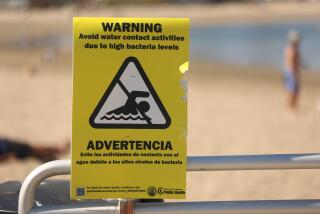Ocean Bacteria Search Will Take Till Midsummer
- Share via
Studies to determine the cause of high ocean bacteria levels that have forced beach closures in Huntington Beach will not be completed until midsummer, a county official said Friday.
Once the cause is known, the county and other agencies will be able to devise a permanent solution to the coastal problem, said Vicki L. Wilson, executive director of the county’s Public Facilities and Resources Department.
Wilson unveiled a county plan to prevent “100%” of the urban runoff from inland cities that has been flushed into the ocean from the Santa Ana River and Talbert Marsh.
The $276,00 plan will divert and treat an estimated 2.5 million gallons of runoff a day. Once permits are secured, county crews will erect concrete rails, walls of sandbags and temporary sand berms at the mouths of major waterways to collect the polluted runoff.
The county is expecting to get all its permits by June 1 and finish work on the sandbag walls and concrete rails by June 7.
The county still must negotiate with the U.S. Fish and Game Service and other wildlife agencies for permits to block the Santa Ana River and Talbert outlet with sand berms, which the county plans to do for up to 10 days during summer high tides.
Talbert Marsh, located on the inland side of Pacific Coast Highway at Brookhurst Street, is a 25-acre wetland that attracts thousands of migratory birds and other wildlife each year.
Wilson acknowledged that diverting runoff, one source of ocean pollution, is only a short-term solution to prevent another round of beach closures. Officials suspect the bacteria has been coming from Talbert Marsh, but still need to know the exact origin to attack the problem.
The county will assume the lead role in the effort. A local sanitation district spent more than $1.5 million in a futile attempt to track down the source of the bacteria a year ago.
Wilson said that Huntington Beach and Newport Beach may benefit the most from the diversion project, but added that the problem needed a regional solution. The watershed includes portions of Santa Ana, Costa Mesa, Fountain Valley, Newport Beach and Huntington Beach. The five cities and the county will share the project’s cost.
Environmentalists applauded the diversion plan, but said more needs to be done.
“The key response first and foremost is protecting public health,” said Mark Gold, with the Santa Monica-based environmental group, Heal the Bay. “So what Orange County is doing is not a Band-Aid but making sure the incredible resources at the coast are kept clean. It’s critical and shouldn’t be trivialized.”
But Gold and other environmentalists called for a comprehensive program to upgrade pipelines and other sanitation facilities, especially because Orange leads other Southern California counties with more than two dozen sewage spills that resulted in beach closures.
“This is a good time to raise the flag of cleaner water quality,” added Christopher J. Evans, executive director of the national Surfrider Foundation in San Clemente. “We need to realize that as we developed the county we’ve destroyed 95% of our wetlands, which serve as nature’s purifiers for rivers and creeks.”
More to Read
Sign up for Essential California
The most important California stories and recommendations in your inbox every morning.
You may occasionally receive promotional content from the Los Angeles Times.













